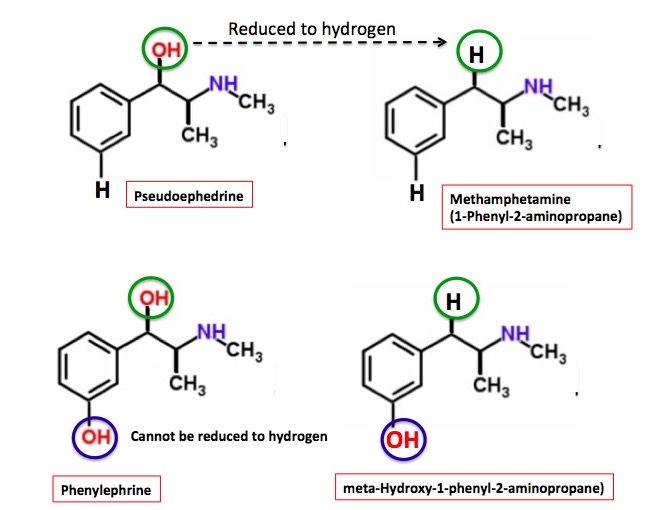The drug phobia that now has us firmly in its grip, you know, the "let's restrict everything" mentality, didn't start with Vicodin, Valium, or Ritalin. It began with Sudafed, which contains the drug pseudoephedrine. If you've watched Breaking Bad you know very well that pseudoephedrine can be chemically modified to produce methamphetamine, aka crystal meth, which is why Sudafed was taken off pharmacy shelves in 2006 (1). To get the decongestant you now have to sniff out the pharmacist counter and hand over your driver's license.
The Act was intended to put a dent in the illegal production of methamphetamine, which was heavily abused at that time, especially in poorer areas of the US. Sudafed was replaced by another decongestant Sudafed PE, which cannot be converted to methamphetamine, but doesn't work as well. Before we take a look at the chemistry that explains this, here is a detailed pharmacological comparison of the two drugs:

Here's the chemistry:

In the first reaction (above), a simple chemical transformation of a hydroxyl (OH) group (green circle) into a hydrogen atom—a process called reduction—is all that is needed to convert (relatively) harmless pseudoephedrine into methamphetamine, which is anything but harmless. There are a number of chemical reagents that can be used for this transformation. Walter White used phosphorous and iodine, a method that no organic chemist in a real lab (and in his right mind) would use. It's messy and dangerous, but it works well enough.
The second reaction (below) is quite different. Phenylephrine contains two different hydroxyl (OH) groups, as shown in the blue and green circles. But the hydroxyl group in the blue circle (called a phenolic group) is chemically unreactive. So if you react phenylephrine with phosphorous and iodine it only the OH in the green circle is affected. The product of this reaction is 3-(2-aminopropyl)phenol, (aka gepefrin), which is a mediocre blood pressure drug sold in Europe. It won't make you high.
So, did removing Sudafed from the shelves of pharmacies accomplish anything except increase sales of Kleenex? Not much, since we organic chemists are a nothing if not creative. In the absence of pseudoephedrine, all that was needed was another method, and Walter White found one, which is far superior to the first. It is called a reductive amination, and, unlike the phosphorous iodine mess, it is clean and very easy. Here is the reaction:

The "P2P" synthesis of meth. A piece of chemical cake.
The problem is that it requires different starting materials, phenylacetone (aka, phenyl-2-propanone, P2P) and methylamine, a gas that smells like ammonia and is sold as a water solution in glass bottles or 55-gallon drums. Methylamine is the chemical in the large drum that they stole from the chemical warehouse. Chemists don't need to steal it. It is a very common reagent, and a bottle or two can be found in most organic chemistry labs. When we order it we get on a list somewhere. P2P is also easy for chemists in a lab to come by. We just order it. There is nothing stopping any organic chemist from making meth and waltzing out of the building with a kilo of it. It would take about an hour to synthesize. The problem is what to do next. How do you get rid of it? A DuPont chemist named Michael Hovey tried something similar in 1985. It did not end well. See: Breaking Really Bad, 25 Years Before Walter White.
A minor problem that "modern" meth makers had to overcome was the difficulty in obtaining phenylacetone (P2P) if you were not in a research lab. So, chemists went back one step made it from something else, another chemical called phenylacetic acid, which is used in the perfume industry, and can be bought in huge quantities.

So, the government took Sudafed off the shelves, meth synthesis became even more efficient, and people sneeze more. SOSDD.
Lessons learned:
- Chemists are smarter than government agencies
- So are wombats
- When government cracks down on something in the futile "war on drugs," something else will pop up that will be even worse.
- If you don't believe this, ask the thousands of families of the fentanyl overdose victims how well cracking down on Vicodin worked from them.
Why was Walter's meth blue? Good luck with this one.
Note:
(1) The Combat Methamphetamine Epidemic Act of 2005, which was incorporated into the Patriot Act was signed by President Bush in 2006.
No comments:
Post a Comment